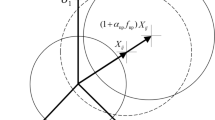Abstract
A transversely isotropic continuum elasto-viscoplasticity model, which was developed from Chaboche’s unified constitutive model, was formulated to capture the thermal mechanical creep fatigue deformation behavior of a directionally solidified nickel-based superalloy. A fourth-order tensor was introduced to model material anisotropy. In order to model the tertiary creep behavior, the Kachanov damage evolution equation was coupled into the stress tensor. Based on the test results of uniaxial tensile, fatigue, and creep loadings at isothermal temperature conditions, the material parameters are obtained. Thermal mechanical fatigue (TMF) and creep–fatigue interaction test results were used to verify the robustness of the model. Additionally, strain–temperature-dependent stress–strain responses under TMF loadings were analyzed using the present model. Under strain-controlled conditions, both of the stress ranges and mean stresses are strongly influenced by the strain–temperature phases, a key parameter for TMF tests.















Similar content being viewed by others
References
Chaboche JL. Constitutive equations for cyclic plasticity and cyclic viscoplasticity. Int J Plast. 1989;5(3):247.
Chaboche JL. A review of some plasticity and viscoplasticity constitutive theories. Int J Plast. 2008;24(10):1642.
Roters F, Eisenlohr P, Hantcherli L, Tjahjanto DD, Bieler TR, Raabe D. Overview of constitutive laws, kinematics, homogenization and multiscale methods in crystal plasticity finite-element modeling: theory, experiments, applications. Acta Mater. 2010;58(4):1152.
Sabnis PA, Forest S, Arakere NK, Yastrebov VA. Crystal plasticity analysis of cylindrical indentation on a Ni-base single crystal superalloy. Int J Plast. 2013;51:200.
Chaboche JL, Gaubert A, Kanouté P, Longuet A, Azzouz F, Mazière M. Viscoplastic constitutive equations of combustion chamber materials including cyclic hardening and dynamic strain aging. Int J Plast. 2013;46:1.
Prager W. A new method of analyzing stresses and strains in work-hardening plastic solids. J Appl Mech. 1956;23:493.
Perzyna P. the constitutive equations for rate sensitive plastic materials. Providence: Brown University; 1962.
Perzyna P. Fundamental problems in viseoplasticity. Adv Appl Mech. 1966;9:243.
Frederick CO, Armstrong PJ. A mathematical representation of the multiaxial Bauschinger effect. Mater High Temp. 2007;24(1):1.
Walker KP. Research and development program for non-linear structural modeling with advanced time-temperature dependent constitutive relationships. Cleveland: NASA; 1981.
Bodner S, Partom Y. Constitutive equations for elastic-viscoplastic strain-hardening materials. J Appl Mech. 1975;42(2):385.
Deseri L, Mares R. A class of viscoelastoplastic constitutive models based on the maximum dissipation principle. Mech Mater. 2000;32(7):389.
Manonukul A, Dunne FPE, Knowles D, Williams S. Multiaxial creep and cyclic plasticity in nickel-base superalloy C263. Int J Plast. 2005;21:1.
Mücke R, Bernhardi OE. On temperature rate terms for viscoplastic constitutive models with applications to high temperature materials. Comput Methods Appl Mech Eng. 2006;195(19):2411.
Becker M, Hackenberg HP. A constitutive model for rate dependent and rate independent inelasticity: application to IN718. Int J Plast. 2011;27:596.
Shenoy MM. Constitutive modeling and life prediction in Ni-base superalloys. Atlanta: Georgia Institute of Technology; 2006. p. 30.
Shenoy MM, McDowell DL, Neu RW. Transversely isotropic viscoplasticity model for a directionally solidified Ni-base superalloy. Int J Plast. 2006;22:2301.
Mengoni M, Ponthot JP. A generic anisotropic continuum damage model integration scheme adaptable to both ductile damage and biological damage-like situations. Int J Plast. 2014;66:46.
Hammi Y, Horstemeyer MF. A physically motivated anisotropic tensorial representation of damage with separate functions for void nucleation, growth, and coalescence. Int J Plast. 2007;23:1641.
Kachanov M. Elastic solids with many cracks and related problems. Adv Appl Mech. 1993;30(1):259.
Rabotnov YN. Creep problems in structural members. Amsterdam: North-Holland; 1969. p. 35.
Kachanov LM. The theory of creep. Boston Spa: National Lending Library for Science and Technology; 1967. p. 30.
Le Graverend JB, Cormier J, Gallerneau F, Villechaise P, Kruch S, Mendez J. A microstructure-sensitive constitutive modeling of the inelastic behavior of single crystal nickel-based superalloys at very high temperature. Int J Plast. 2014;59:55.
Shi DQ, Dong CL, Yang XG. Constitutive modeling and failure mechanisms of anisotropic tensile and creep behaviors of nickel-base directionally solidified superalloy. Mater Des. 2013;45:663.
Chaboche J. Viscoplastic constitutive equations for the description of cyclic and anisotropic behavior of metals. Bull Acad Polon Sci Ser Sci. 1977;25(1):33.
Ohno N, Wang J. Transformation of a nonlinear kinematic hardening rule to a multisurface form under isothermal and nonisothermal conditions. Int J Plast. 1991;7:879.
Benallal A, Cheikh AB. Constitutive laws for engineering materials. New York: ASME Press; 1987. p. 145.
Frenz H, Meersmann J, Ziebs J, Kühn HJ, Sievert R, Olschewski J. High-temperature behaviour of IN 738 LC under isothermal and thermo-mechanical cyclic loading. Mater Sci Eng A. 1997;230(1):49.
Tsai SW, Wu EM. A general theory of strength for anisotropic materials. J Compos Mater. 1971;5(1):58.
Li SX, Smith DJ. Development of an anisotropic constitutive model for single-crystal superalloy for combined fatigue and creep loading. Int J Mech Sci. 1998;40(10):937.
Ohno N, Wang JD. Kinematic hardening rules with critical state of dynamic recovery, part I: formulation and basic features for ratchetting behavior. Int J Plast. 1993;9(3):375.
Kang G. Ratchetting: recent progresses in phenomenon observation, constitutive modeling and application. Int J Fatigue. 2008;30(8):1448.
Gordon AP. Crack initiation modeling of a directionally-solidified nickel-base superalloy. Atlanta: Georgia Institute of Technology; 2006. p. 139.
Chataigner E, Remy L. Thermomechanical fatigue behaviour of coated and bare nickel-based superalloy single crystals. In: Thermomechanical fatigue behavior of materials: second volume. Phoenix: ASTM Special Technical Publication; 1996. p. 3.
Acknowledgments
This research was financially supported by the National Basic Research Program of China (No. 2015CB057400).
Author information
Authors and Affiliations
Corresponding author
Rights and permissions
About this article
Cite this article
Hu, XA., Yang, XG., Shi, DQ. et al. Constitutive modeling of a directionally solidified nickel-based superalloy DZ125 subjected to thermal mechanical creep fatigue loadings. Rare Met. 38, 922–936 (2019). https://doi.org/10.1007/s12598-016-0713-8
Received:
Revised:
Accepted:
Published:
Issue Date:
DOI: https://doi.org/10.1007/s12598-016-0713-8




